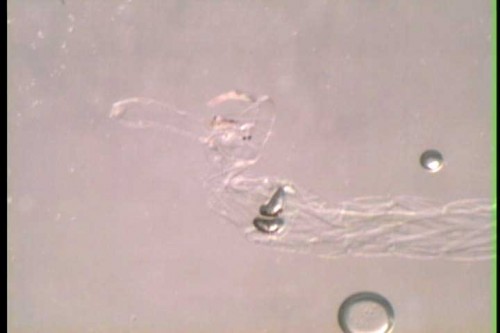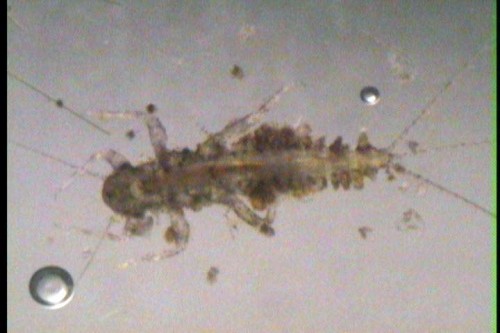This morning at Itasca I’ve set up a photomicrography station — I brought up my nice Wild M3C with a phototube and a meh video camera, so the students can take pictures of the plankton and other stuff they dredge up from the lake out there. So I sent them off to do the fun stuff, while I buckled down to assemble all the gadgets and connect up all the cables and test out the software. I gave myself an hour to get it done, because there’s always something that goes wrong.
Nothing went wrong. Click click click, all the pieces went together and I was done in a minute. I guess now I’m going to have to take a walk or something until the boat gets back.
Whee! The lake is full of monstrous critters! Here’s Chaoborus, or the phantom midge.
How about a mayfly?




Sandcastles!
There are easier ways to acquire an empty boat.
Things will, of course, go wrong the instant the boat gets back and the students try to use the gear. That’s just the way it works.
Plankton! Watching the young’uns discover & learn. You are a lucky man.
Conservation of Murphy. Better make sure the lake didn’t vanish.
I love that you weren’t scared of jinxing it!
#3: Wrong! Everything is working perfectly!
Except I really should have brought my fiber-optic light source. This cheapie lamp isn’t quite bright enough.
Nothing works as well as a microscope lighted by a reflecting mirror. Especially on a 90º day and… humidity. Bulbs go bust all the time. And today I am not driving from Fargo to get your autograph, but one day I will.
@PZ #7: Like Chengis says, nothing beats the sun when it comes to light sources. Except 2 or 3 gazillionty other stars, of course, but they’re a long ways away!
The universe in a drop of water … or just tiny leviathans.
the phantom midge.
Worst. Prequel. Ever.
as people say,”i did’nt need to see that”
i was on a canoe trip for a couple weeks and we just drank out of the lakes.
Hey PZ – I know you’re kinda busy at the moment, but when you get a chance could you go into just a few details on your microscope setup? I’m strictly a hobbyist who has a couple biology courses under her belt and some water-sample lab experience, and have wanted a microscope of my own ever since so that I could nose around in pond water, mold, or whatever grabs my fancy.
Just to get me started in my search, would you recommend at least 2000x magnification? Higher? I can’t spend thousands of dollars on this and have seen some nice microscopes that will magnify from 40x to 2500x at fairly reasonable prices. Imaging capabilities would also be nice. Any suggestions?
No! Forget magnification!
You want to care about numerical aperture and lighting. A scope with a real condenser is important, and we measure objective quality by N.A.
Most hobbyists are best off getting a simple dissecting scope. My Wild is a fairly high end scope of that type, and it set me back somewhere around $1K ten years ago — I see them now for $600-$700 on eBay. Look into Lomo for cheaper versions. Get a photo tube and an adapter for a standard digital SLR (I’ve got a Nikon Coolpix with a simple machined adapter, for instance), and you’re good to go.
But really, that’s the first mistake I see novice buyers make, looking at the magnification. Get the mag you need for your specimens, of course, but it’s the other parameters that are far more important.
THANK YOU! Sorry for screeching, but this was exactly the kind of info I needed. Microscopes are like just about everything else you try to buy today – you start looking around and get completely overwhelmed. And of course, every company tells you their microscope is the best buy for whatever you’ve got in mind, and will do everything you need and more! I’ve copied and pasted your reply and will start reading up on numerical aperture, lighting and condensers – something that wasn’t even on my radar in my earlier searches. Thanks again.
This. Is. Terrific!
And timely too. As one who has been looking the other way for so many years (telescope-wise) I’ve been getting jazzed lately on returning to my childhood fascination in exploring with a microscope…this time with a better appreciation of what I’m really doing, examining a known critter-infested world in detail. Awesomeness to be discovered…
Yes, the drooling after magnification is a mistake common to novices looking to buy their first telescope too. And many are disappointed upon getting introduced to what observing is really like at star parties full of very fine amateur instruments when they don’t see bright color-saturated Hubble-class images in the eyepiece. Alas, the patience and finesse required to observe the subtle details of the real world is not well sharpened in those stuffed on a diet of video games that do nothing but drain time in exchange for empty stimulus. And we wonder why science illiteracy and denialism is burgeoning.
PZ, submit a video to the Imagine Science Films Scenes project! http://www.imaginesciencefilms.org/programs/scenes/
dude.
It’s almost September.
Random factor, beer on my screen from totally unexpected laughter.
Thank you.
A transparent larva? Radical!